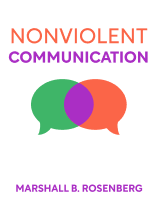

This article is an excerpt from the Shortform book guide to "Nonviolent Communication" by Marshall B. Rosenberg. Shortform has the world's best summaries and analyses of books you should be reading.
Like this article? Sign up for a free trial here .
What is the NVC conflict resolution method? How does it differ from the traditional compromise-oriented approach?
Unlike the traditional approach to conflict resolution, the nonviolent communication (NVC) method does not aim for a compromise. Instead, the NVC approach focuses on what both parties need and creates solutions that will meet those needs in full.
Read about the NVC conflict resolution process and how it is executed in practice.
What Is NVC Conflict Resolution?
NVC is a helpful tool for any type of communication, but it is especially useful for conflict resolution, mediation, and counseling others. In the author’s years of experience applying NVC with all kinds of people and all types of conflicts, he found that almost every conflict can eventually be resolved if everyone commits to following NVC principles.
In this context, “conflict resolution” refers to the process of resolving conflicts between yourself and another person; “mediation” refers to helping others resolve a conflict in which you are not involved.
The Importance of Human Connection in NVC
Establishing a human connection between the people involved in a conflict is the most important part of Nonviolent Communication. Without that connection, none of the other steps will be useful because neither party will be motivated to truly understand the other. In fact, creating a genuine human connection is the true goal of NVC—either party getting what they want is a byproduct of that relationship. To successfully resolve a conflict with NVC, everyone involved must understand and agree to that goal.
The emphasis on human connection differentiates the NVC approach from traditional mediation and conflict resolution techniques. In traditional mediation, the mediator’s goal is to get everyone to agree to a single solution. Establishing any kind of genuine connection between the people involved is out of their purview—many mediators even see the NVC approach as a form of psychotherapy, not mediation. In reality, the NVC approach to conflict resolution is much more efficient: Instead of offering solutions first and asking for feedback, NVC focuses on what both parties need and creates solutions that will meet those needs in full.
When the people on both sides of a conflict establish a human connection and a sense of mutual respect, they’ll understand that their own needs and the other person’s needs are equally important. Therefore, the goal of conflict resolution in NVC is not compromise. In a compromise, neither party’s needs are fully met—even if the immediate problem is smoothed over, those remaining unmet needs will only cause further problems down the road.
Throughout the entire process of resolving a conflict using NVC, both parties should avoid language that labels, blames, or implies wrongness, since that kind of language often brings empathic conversations to a halt.
The Five Steps of NVC Conflict Resolution
The NVC conflict resolution process has five steps. (As noted, the first two steps are reversible—the important thing is to focus on giving everyone a chance to express their needs before moving on to solutions.)
- Express your own needs.
- Identify the other person’s needs (this can also be done before expressing your own needs).
- Verify that both of you accurately understand each other’s needs.
- Provide empathy.
- Propose strategies that meet everyone’s needs.
Step 1: Express Your Own Needs
In this step, be careful to differentiate between needs and strategies. Needs are the fundamental physical and psychological resources that sustain life, like water, food, meaning, and support. Needs can be met with a number of different strategies—specific actions that fulfill a need. It’s sometimes difficult to tell needs and strategies apart because we’re not used to openly and vulnerably sharing our needs. The fundamental difference is that need statements don’t refer to any person doing any particular action.
For example, the statement “I need you to leave me alone for a minute” is a strategy, not a statement of need, because it references someone doing something. A true need statement in that situation might be “I need quiet in order to focus.” That statement leaves the door open for many possible solutions (like earplugs or going to a different room) instead of mandating a certain action.
It can be tempting to couch need statements in intellectual analysis by starting a statement with “I think” instead of “I need.” Unfortunately, people often interpret analysis as criticism, which can shut down the conversation. For example, saying “I need to express myself more clearly so I can feel understood” instead of “I think you’re misunderstanding me” avoids the analysis trap and keeps the focus on needs.
Step 2: Identify Others’ Needs
If the person you’re communicating with isn’t practicing NVC, they might express their needs in more indirect ways. Silence, rejection, judgmental comments, and nonverbal cues are all veiled statements of need. By recognizing these and translating them, you can keep the conversation flowing nonviolently even if the person you’re talking to isn’t playing along.
Identifying needs expressed through judgment or silence usually involves a degree of guessing. People often use the same cues to express different needs or emotions (like sighing heavily to express exhaustion, frustration, or sadness), so it’s important to check that guess with the other person. This might be a continual process, since most people are more likely to respond with a second indirect expression rather than a clear “Yes, you interpreted my needs correctly.”
Step 3: Verify That Everyone’s Needs Have Been Heard
Once you’ve expressed your own needs and identified the other person’s needs, it’s helpful to check that you both understand each other correctly. We often skip this step because we incorrectly assume that when one person clearly expresses a need, the other person hears that need exactly the same way.
In practice, this process is a simple but powerful way to avoid further miscommunication down the line. After you’ve listened to someone’s needs, paraphrase those needs back to them to check your understanding; after you’ve expressed your own needs, you can ask them to do the same.
Step 4: Provide Empathy
When people are hurting, they often can’t hear the needs and feelings of others until their own pain has been recognized and understood. The conversation can’t move forward until they get the empathy they need (but just like in any conversation, if you’re feeling too many strong emotions yourself to provide that empathy, it’s best to step away and give yourself some emergency first-aid empathy first). If you skip ahead to the solution phase, the underlying feelings and needs will linger—even if you resolve the conflict on a practical level, the relationship will suffer.
Step 5: Propose Solutions
Remember, solutions in NVC are courses of action that meet everyone’s needs rather than asking people to compromise. Propose solutions using present language by requesting what you need in this moment in order to move forward. This keeps the conversation moving because it gives the other person the chance to either agree or refuse right in the moment. This creates an immediate feedback cycle—if they refuse, you can continue problem solving—rather than having to resume the conversation days or weeks later.
For example, instead of saying, “I want you to come to the party with me this weekend” and then having to wait several days to see if the person follows through, you can say, “I’d like you to tell me if you’d be willing to go to the party with me this weekend.”
It’s also helpful to use positive action language when proposing a solution (by asking for what you do want right now instead of what you don’t want) so that your request is clear and specific. However, word choice is important, as some positive action language is easy to mistake for a judgment or attack. For example, “I want you to listen when I speak” or “I want you to be responsible” feel like accusations.
To avoid this, focus your request on things that can be immediately seen or heard. Imagine your conversation is being filmed—your requests should be for things that would be picked up on camera (unlike “listening” or “being responsible,” which are abstract ideas).
Remember, a true request is one that the person is free to say “no” to without fear of punishment. If they do refuse your request, listen for the need behind that refusal that is preventing them from saying yes, then try to propose solutions that will also meet that need.
Example: Resolving a Decades-Old Marital Conflict
Let’s use a real-life example to illustrate this process. In one of Rosenberg’s NVC workshops, he mediated a conflict for a married couple who had been arguing about their finances for almost forty years. He began by asking the wife if she could identify her husband’s needs in this conflict. Her answers reflect common mistakes people make when identifying needs:
- First answer: “He doesn’t want me to spend money.” Whether or not this is true, it’s a strategy, not a need, because it references a specific person doing a specific action.
- Second answer: “He’s just like his father.” This is an analysis, not a need. Again, even if it’s true, this statement isn’t helpful for resolving the conflict.
At this point, Rosenberg intervened and asked the husband to express his needs directly. The husband responded with “She’s a wonderful wife, but she’s totally irresponsible with money.” That’s a diagnosis, not a statement of need. Rosenberg listened for the underlying need and took a guess by asking the man if he was afraid because he needs to provide for his family economically. His guess was correct—they’d finally identified the husband’s underlying need.
After the husband finally expressed his need clearly, Rosenberg asked the wife to repeat that need back to him. She responded, “Just because I overdrew the checking account a few times doesn’t mean it will happen again.” This is self-defense, and it’s a common response that indicates someone is in too much pain to really hear someone else’s statement of need. In this case, the wife was so hurt from years of feeling distrusted that she wasn’t open to hearing her husband’s needs until that pain was validated. Rosenberg empathized by paraphrasing her feelings and needs around the issue of money.
A few minutes of focused empathy didn’t instantly erase forty years of hurt, but it did provide enough reassurance that the woman’s pain was being heard that she was able to finally hear what her husband was saying. In turn, she was able to express her own needs and clarify that her husband was hearing them correctly.
Once the two spouses had fully expressed their own needs and verified that they each understood the needs of the other, coming up with solutions to the problem only took about 20 minutes. Solving a forty-year-old issue in 20 minutes sounds impossible, but it highlights just how much of a conflict isn’t about the issue itself but the needs and feelings of the people involved.
When Using Force Is Necessary
Unfortunately, we can’t always resolve conflicts with conversation, especially if there’s a threat of immediate harm (for example, if you witness two teenagers launch into a fist fight). In that case, it may be necessary to use physical force in order to keep people safe. The NVC paradigm recognizes that force is sometimes necessary to prevent immediate harm, and that force can be a tool of nonviolence as long as it is used protectively and not punitively.
To understand this distinction, imagine a parent playing outside with their young child when the child suddenly darts into the street. Physically intervening by grabbing the child’s arm and pulling them back to safety is an example of protective force because the inten is to prevent immediate bodily harm. The parent’s sole focus is protecting their child, and they aren’t making any judgments about the child’s behavior.
On the other hand, if the parent then turns around and spanks the child for running into the street in the first place, that’s a punitive use of force—the parent has evaluated the child’s behavior, judged it as “bad,” and determined that the child deserves to be punished with force.
Protective Force
Protective force can take many forms in addition to physically restraining someone who is about to harm themselves or others. For example, in schools, the use of a “do-nothing room” where students can go if they’re not ready to work is a form of protective force. Students aren’t physically forced into the room—they can ask to go, or be asked by a teacher to go, if they’re causing a distraction for other students. (“Force,” in this case, refers to the distractions caused by rowdy students being contained to the do-nothing room.) The intent is to protect students who do want to work, not to punish students for being off task.
What truly sets protective force apart from punitive force is the set of assumptions behind it. When we use force protectively, the assumption is that the threat of danger is a result of ignorance, not malice. In this context, “ignorance” can take several forms:
- Being unaware of consequences (like the young child darting into the street)
- Not being able to identify other strategies to meet a need
- Mistakenly believing that some people are “bad” and “deserve” punishment (in reality, “badness” is a subjective judgment, not an objective fact)
- Delusional thinking or psychosis
All of these definitions of ignorance acknowledge that when people endanger themselves or others, they do so because they have unmet needs (for justice, attention, medical care, and so on), not because they are fundamentally bad people.
Punitive Force
On the other hand, the assumption behind the use of punitive force is that some people are evil, and when they do things we disagree with, they deserve to be punished. The punishment should be severe enough to make them really suffer because only suffering will make them repent and change their behavior. These assumptions are the polar opposite of the tenets of NVC, and punishment often backfires by creating hostility or resentment instead of positive behavior change.
Even if punitive force does create behavior change, it’s likely motivated by fear or shame rather than a genuine desire to do better. This distinction matters more than many people realize in day-to-day situations. For example, if you tell your child to clean their room, what do you want their motivation to be for doing it? Do you want them to do it because you hope to instill an appreciation for neatness and help them develop skills they’ll need in adulthood—or because they’re afraid of being punished if they don’t comply? Most parents would choose the former, but using punitive force is more likely to result in the latter.
Punitive force is not always physical. Using blame or name-calling as punishment is a form of punitive force because it assigns a value judgment to a person or their behavior. Withholding privileges can also qualify as punitive force when the intent is to punish someone and ultimately make them change their behavior.
Corporal Punishment
Corporal punishment is a type of punitive force that is mostly directed at children. Any use of physical force on a child for the purpose of “teaching them a lesson” is corporal punishment—including spanking. Some parents swear by spanking as an effective method to alter their children’s behavior. They think of spanking as a genuine act of love because it prevents their children from doing things that could be dangerous and provides the strict limits that generally make children feel safe.
The flaw in this argument is that viewing spanking as a loving act requires logical reasoning, which children haven’t yet developed. For a child, there is nothing loving about spanking—it just hurts. Over time, repeated experiences with spanking send the message that violence is an acceptable way to solve problems.

———End of Preview———
Like what you just read? Read the rest of the world's best book summary and analysis of Marshall B. Rosenberg's "Nonviolent Communication" at Shortform .
Here's what you'll find in our full Nonviolent Communication summary :
- How nonviolent communication lets you have more compassion for yourself
- Why nonviolent communication is the key to fostering authentic connections with others
- The 4 steps to expressing yourself with empathy towards others






